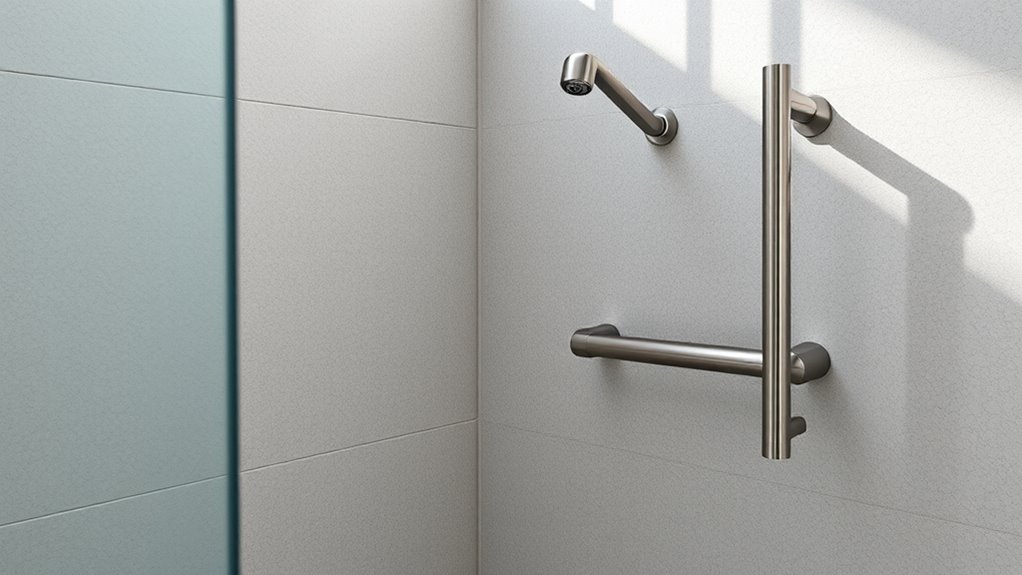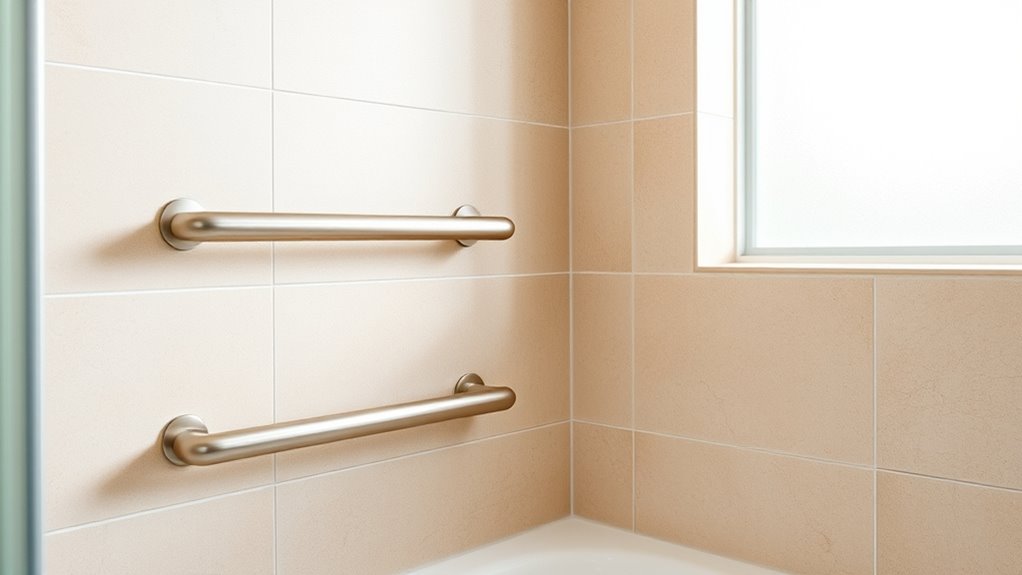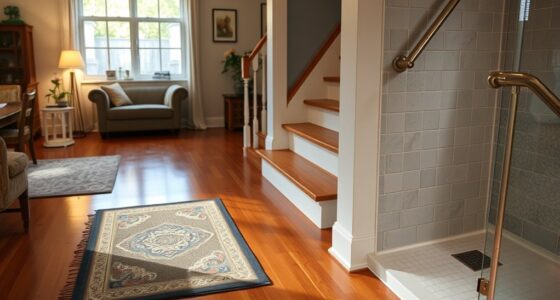Proper grab bar placement is vital for your safety and independence in the bathroom. Installing horizontal bars 33 to 36 inches above the floor near the toilet provides essential support when sitting or standing. In showers, add horizontal bars along the back wall and vertical ones near entrances to prevent slips. Strategic placement around sinks also boosts stability. If you want to guarantee the best support, understanding these key points will help you make smarter choices.
Key Takeaways
- Proper placement ensures maximum support and safety during transitions like sitting, standing, or moving in bathrooms.
- Installing grab bars at recommended heights (33–36 inches) optimizes accessibility and stability.
- Strategic positioning near toilets, showers, and sinks reduces fall risks during daily routines.
- Understanding natural bathroom movements helps in placing grab bars where they are most effective.
- Thoughtful placement preserves independence, confidence, and reduces injury risks for users with mobility challenges.

Proper placement of grab bars can markedly enhance safety and independence in bathrooms. When you install grab bars thoughtfully, you’re not just making the space look complete; you’re creating a safer environment that supports daily activities and reduces the risk of falls. Bathroom safety is vital, especially for seniors or anyone with limited mobility, as falls in the bathroom can lead to serious injuries. By positioning grab bars correctly, you help preserve elderly independence, allowing them to move around more confidently and with less fear of slipping.
The key to effective grab bar placement lies in understanding how people naturally move within the bathroom. For example, near the toilet, the grab bar should be installed horizontally about 33 to 36 inches above the floor, providing a sturdy support point when sitting down or standing up. This position offers stability during one of the most common and potentially hazardous bathroom activities. When you place the bar at the right height, you’re making movements safer and easier, especially for elderly individuals who may struggle with balance or joint pain.
In the shower or bathtub area, grab bars should be positioned horizontally along the back wall, typically 33 to 36 inches above the floor, and sometimes vertically near the entrance. If you have a bench or seat, install a grab bar nearby to assist in sitting and standing. For added safety, consider placing a vertical grab bar near the shower controls for support when entering or exiting. Proper placement here can greatly reduce slips caused by water or soap, which are common hazards in bathroom safety.
Don’t forget about the importance of placement in relation to the sink and vanity. A horizontal grab bar installed underneath the sink, about 4 to 6 inches above the floor, can help with stability when getting up or sitting down. The goal is to ensure that grab bars are within easy reach from any position a person might be in—whether standing, sitting, or transitioning. When you position grab bars strategically, you enable elderly independence by allowing individuals to perform daily routines with confidence and less reliance on others.
Understanding tuning principles can also inform how you optimize your bathroom setup; for example, considering how users move naturally can help determine the most effective grab bar locations. Ultimately, the right placement of grab bars isn’t just about following guidelines; it’s about understanding how you or your loved ones move in the space. Properly installed grab bars make a tangible difference in bathroom safety and help maintain independence longer. When you prioritize correct placement, you’re investing in a safer, more accessible bathroom that supports dignity and autonomy for everyone, especially those who need it most.
Frequently Asked Questions
Can Grab Bars Be Installed Outdoors Effectively?
Yes, you can install grab bars outdoors effectively. Choose models with weather resistance to withstand elements like rain and sun, ensuring durability. Opt for aesthetic options that blend seamlessly with your outdoor decor. Proper installation is key; secure them into sturdy surfaces like concrete or treated wood. This way, you get reliable support and maintain an attractive appearance, making your outdoor space safer and more accessible.
Are There Specific Materials Best Suited for Different Environments?
When choosing grab bar materials, consider environmental durability to match your specific setting. For outdoor use, opt for stainless steel or coated metals that resist rust and corrosion. For indoor environments, plastic or PVC can be suitable, but make sure they’re sturdy enough for safety. Your material options should prioritize weather resistance and strength, ensuring longevity and dependable support in any environment.
How Do I Choose the Right Size for My Space?
Picking the perfect grab bar size starts with precise measurements to prevent pesky installation challenges. You want grab bar aesthetics that blend seamlessly with your space, so measure your space meticulously—considering height, reach, and available clearance. Smaller bars work well in tight corners, while longer ones provide more support. By matching size to your specific space, you ensure safety, style, and a smooth, stress-free installation process.
What Are the Weight Limits for Various Grab Bars?
When considering grab bars, you should check the weight capacity to guarantee safety. Most standard grab bars are designed to support at least 250 pounds, meeting safety standards. Heavy-duty options can support up to 500 pounds or more for added security. Always verify the manufacturer’s specifications to match your needs and ensure proper installation, so you feel confident in their ability to provide stability and support during use.
Can I Install Grab Bars Myself Without Professional Help?
Imagine installing a sturdy bridge for your safety—DIY installation can feel like that. You can probably handle it if you’re comfortable with basic tools and follow safety considerations carefully. However, remember, grab bars are like lifelines, so make sure they’re securely anchored for maximum support. If you’re unsure about your skills, consulting a professional guarantees your safety and the proper placement, making your home truly accessible.
Conclusion
Remember, the right placement of grab bars provides safety, boosts confidence, and encourages independence. Proper placement supports your balance, prevents falls, and promotes peace of mind. It’s not just about where you install them, but how they integrate into your daily routine. When you prioritize thoughtful placement, you prioritize your well-being. So, measure carefully, install confidently, and use your grab bars wisely—because safety isn’t a one-time task; it’s a continuous choice.









